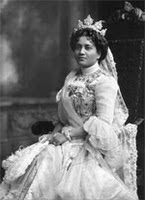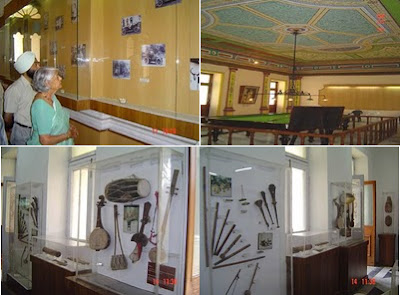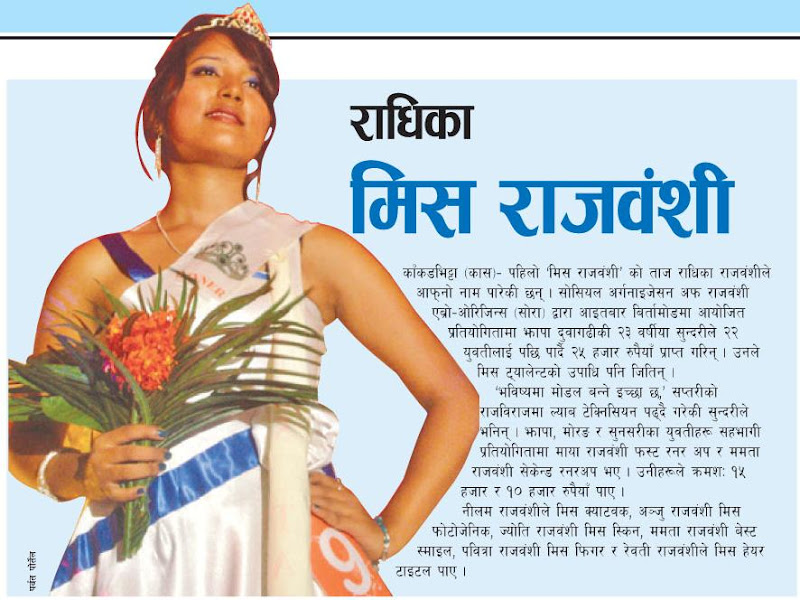
Glorious History of Rajbanshi “The Royal Blooded”
SORA-Arun Rajbanshi, Ghailadubba, Nepal
According to the famous researchers and Anthropologists, Historians, Writers the ancient tribe Rajbanshi used to reside in the southern part of churiya Range of Mahabharata range in south eastern plain of Asia continent during pastoral stage of Human civilization (Pastoral stage means the beginning period of civilization when human beings had started to keep domesticated animals). According to the survey of Anthropologists and writers like Sir Edward Gait, Edit Hiten Nag, Hamilton, Sarat Chandra Ghaosal, Sunit Kumar Chattarji Charuchanda Sanyal, Dr. Dijendra Bhagat, Dr. Lakhi Devi this Rajbanshi Tribe inhabited between southern part of Koshi River and Brahamaputra river before Aryan Civilization evolution and these people used to communicate in Rajbanshi language. According to the available facts and evidences it can be said that Rajbanshi tribe are the oldest inhabitants of eastern terai o f Nepal and they have important role to make the area cultivable and fertile. This area was called Pragya Jyotish and ancient Kamrup which can be studied in Holy books like Mahabharat , Ramayan, Tantra puran etc. In Mahabharat it is written that Pragya Jyotishpur includes Jalpaiguri, Kochabihar, Rangpur, Mainamsingh, Dhaka, Tripur, Pabna, Eastern Part o f Nepal till Koshi river, Assam, Eatern part of Bihar. The capital o f pragya jotis was pragya Jyotispur now called Gwahati Assam. (Sir Edward Gai- The history of Assam). According to history Rajbanshi King Narkasur defeated king Ghatak and ruled pragyajyotishpur. After Narkasur the reign was taken by Bhagdath. We can study in the Journal of International History Conference of 16 Dec, 1979 Delhi that Bhagdath fought in Kuruchetra war of Mahabharat from side of Kaurava. If we study about the mediaval period history of Rajbanshi Kings pragya Jyotishpur or Kamrup was ruled by Rajbanshi Kings since 4th till 12th century( The History of Koch Bihar, Page 81). Similarly in 5th century famous Rajbanshi kings were kalian Barma, Ganapati Barma, Mahendra Barma, Marayan Barma, 6th century famous Rajbanshi Kings were Bhuti Barma, Chandra Mukh barma, Stita Barma, Sustita Barma and in 7th century Bhaskar Barma was the famous king. (Chinese writer Hu En Sang in his travel documentary book 943 A.D), Similarly 8th century famous Rajbanshi king pulka, Kumara, Bajradev, Shree Hari, Rajbanshi Kings of 9th century Pralav, Harjara, Banamala, Jaya Mala, Bir Bahu, in 10th century Bala, Tyagiya , Bramapal, in 11th century Ratna pal, Purandhar pal , indrapal, Gopal, Harsapal, in 12th century Dharmapal, Tingdev, Baidhadev, Balav dev( Page-17 of History of Koch Bihar).
After 12th century land was divided into 12 states. After that brave Rajbanshi King Hajo defeated the divided rulers and ruled Kamrup. (Page 89, History of koch Bihar). According to Rai GunBikaram Barua, The name of Hira’s father was Hajo or hakhia the king of kamrup. (Dr. Latham’s Ethnology of India, Colonel Dalton’s Ethnology of Bengal and Notes on Assam Temple ruins, Page 90, A History of koch Bihar). So, we can say that Hira was daughter of King Hajo. Hira was most beautiful princess so she was married to Haridas Mandal at the age of 9 years. As she was child she was kept in palace till she acquired maturity and then Hajo gave Hariya Mandal his daughter along with sister Jira. Hariya Mandal was not from Rajbanshi Trive but Hira and Jira were Rajbanshi Trive so according to matriarchal culture o f Rajbanshi Tribe the King Hariya Adopted Rajbanshi Cultural Religion. Hira gave birth to Bishu and Jira gave birth to Sishu. This thing I want to clarify from the history of Indian leader Jwaharlal Nehru’s only daughter Indira Gandhi who got married to muslim Husband Firoj Khan but according to matriarchal culture the sons Rajiv Gandhi and Sanjay Gandhi are from Gandhi family. According to Historian late Kanaklal Barua Bishu and Sishu were most powerful brave Rajbanshi Kings to extend their territory from Morang pradesh(Jhapa, Morang, Sunsari, Ilam of Nepal) till Assam. After the death of Hajo the kingdom of Hajo also was included and made great Kamtapur Kingdom. In 1490 AD king Bisu acquired Hindu religion and changed his name as Biswa Singh and called him self Rajbanshi. So the title Rajbanshi started to be written by people from his regime. He changed his brother name sishu to Shiv Singh and was made commander in Chief of Great Kamatapur. They extende their territory till Asssam, Burma in east, Saptakoshi in West, Sikkim, Bhutan in North, Bangladesh in South and made greatest Kamatapur. Biswasingh took census of his country and it was the first census in the history of world. He is said to have found that the numbers of able bodies’ man capable of bearing arms as army was 5252000. He divided off the people under various categories officers viz Thakarias over 20 men, Saikas over hundred, Hazarias over thousand, Umras over three thousand and Nawabs over sixty thousand. He is daid to have possessed a large number of elephants, horses, asses, buffaloes, camels. He married number of wives by whom he had nineteen sons, including mall dev, Sukla dhwaj, Narsingh and Gohain Kamal. He died in 1540 A.D. After his death elder son Narsingh became king. His mother was Ratna Kanti mall the daughter of Pratap Malla. The citizens were not satisfied with the rule of Narsingh so he handover the kingdom to sukladhwaj and Narnarayan and came to Kathmandu Nepal. So, Now a days we can get few peoples in Kathmandu who calls themselves Rajbanshi . Sukladhwaj extended his territory till Morang state of Nepal where he stayed longer time and made Bijaypur (Dharan, Sunsari) his capital and made a big pond for his personal use which is still and place is called Chilhara (after his name Chila ray). In 1540 A.D Malla dev changed his name Nar Naryan and ruled the land. He minted coins named Naryani from that period. He made Sukladhwaj (Chila Ray) the prince. Sukladwaj was brave warrior he used to attack the enemies in the speed of electric current like eagle which attack its prey. So, he was called Chila Ray. Sukladwaj (Chila Ray) was the world’s Top brave Warrior, Second was Chatrpati Sivaji, Third Nepolean Bornapart from England. During rule of Nar Narayan and Chila Ray the territory of Rajbanshi Kingdom was Sadia, Naga, Barma , Manipur, Tripura in East, Koshi River in west, Bhutan, Sikkim, Tibet in North and Rangpur of Bangladesh, Dinajpur, Bangur, Silet, Bay of Bangal in South. (From page 13 of Hamar Samaj by Thaknu Rajbanshi, Madhu parka magazine kartik 2051 B.S page 35 by Prof. Drona pd. Upadyaya).
In Conclusion we can say that the demand of Secular Autonomous State with Self Decisive rights and compensation by Rajbanshi community of Nepal must be given and mentioned in New constitution of New Nepal inorder to bring peace, stability, national unity and integrity and formation of New Nepal.
Maharani Gayatri Devi was the last of the Queens of Jaipur in Rajasthan , India.Gayatri Devi was listed by the Vogue as one of the world's most beautful women, and was a favourite of society columnists and photographers.Gayatri Devi was the daugher of Maharaja Jitendra Narayan and Mahrani Indira Devi of the 'Koch' dynasty of Cooch Behar.Born in 23rd May, 1919.Gayatri Devi travelled extensivley with her mother and family in Europe.Gayatri Devi Studied at Shantiniketan and abroad, and speaks several languages.At the age of 19, she fell in love with Man Singh, the heir to the Jaipur throne.Their marriage was initially opposed by her parents, as Man Singh already had two wives, the daughters of the Maharaja Jodhpur.However, they gave in to her determination, and she was married in 1939.The jaipur royal family lived a lavish life with hunting, summers in London,children educated in England, and streams of famous visitors which was normal for rulers of principalities at that time.
Man Singh was the last ruler of Jaipur and oversaw its transition to a secular part of rajasthan state in independent India.He served as India's first ambassador to Sapin.Maharaja Man Singh died in 1970 while playing polo.
Gayatri Devi started schools for girls education in Jaipur, and promoted the dying art of blue pottery
In 1962 she entered politics, and won an astounding majority to become the Lok Sabha representative.(She still holds the Guiness record for this electoral majority).She won the seat again in 1967 and 1971 from the Swatantra Party , running against the Congress party.This enraged Indira Gandhi, who retaliated in 1971 by abolishing the pivy purses, and stopping all the royal privileges, breaking the treaties agreed upon in 1947.Gayatri Devi was accused of breaking tax laws, and served 5 months in Tihar jail.She retired from politics after thet experience and published her autobiography "A Princess Remembers" written with Santha Rama Rau in 19776.She was also the focus of a film called "Memoirs of Hindu Princes" directed by Francois Levie.
Gayatri Devi (23 May 1919 - 29 July 2009), often styled as Maharani Gayatri Devi, Rajmata of Jaipur, was born as Princess Gayatri Devi of Cooch Behar. She was the third Maharani of Jaipur from 1939 to 1970 through her marriage to HH Maharaja Sawai Man Singh II. The royal titles and the accompanying privy purses were technically abolished through a constitutional amendment in 1971.
Following India’s independence and the subsequent abolition of the princely states, she became an extremely successful politician. Gayatri Devi was also celebrated for her classical beauty and became something of a fashion icon in her adulthood.
She passed away on the July 29, 2009 aged 90 in Jaipur. She was suffering from paralytic illus.
Cooch Behar Royal Dynasty Image-Rajbanshi history says
---Royal Family Tree Of Koch (Rajbanshi) Kings---
 |
| Maharaja Jirendra Narayan Bhup Bahadur of Koch Behar Royal Family | | | |
 |
H.H. Maharani Sinti Devi, CI (18 March, 1887) (Born at Sens House, Calcutta, 1864, Died at Ranchi, 10th Nov, 1932) Somtime regent at Cooch Bihar, President of the State Council The eldest daughter of Babu Keshab Chandra Sen Married 5 March1878 Colonel H.H, Maharaja Shri Sir Nripendra Narayan Bhup Bahadur |
 |
Colonel H.H Sir Nripendra Narayan Bhup Bahadur, Maharaja of Cooch Behar |
 |
Four sons of H.H Sir Nripendra Narayan Bhup Bahadur, Maharaja of Cooch Bihar |
 |
(dated 26th Sept, 1913) Maharaja Jitendra Narayan Bhup Bahadur (1913-1922) |
 |
Maharaja Jagad Dipendra Narayan(left-side),Rajmata Indiradevi (centre), Prince Indrajit Narayan(left-side) |
 |
(dated 23rd Oct, 1902) Maharaja Raj Rajendra Narayan (1911-1913) |
 |
dated 6th Jan, 1899 Maharaha Nripendra Narayan |
 |
dated 1863-1911 Maharaja Nripendra Narayan Bhup Bahadur |
 |
| The Cooch Behar Palace, of the royal "Koch" dynasty & remarkable for its wonderful architechture & grandeur, is undertaken & being developed by the Archeological Survey of India as museum. |
 |
Rajbari-Durbar Floor Rajbari Exibits |
 |
Rajbari -Billiards Royal symbol ko 'koch' dynasty |
 |
| Rajbari musical Instruments |
 |
Suniti Devi-Queen and Eladevi- daughter of Maharaja Jitendra Narayan |
 |
Rajbari Stone Sculpture |
 |
Maharaja Jitendra Narayan Bhup Bahadur |
 |
| Coins of Currency |
|
 |
| Stone Structure in palace |
|










































